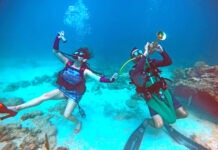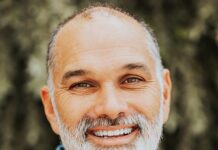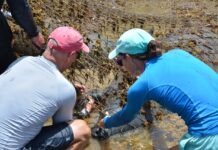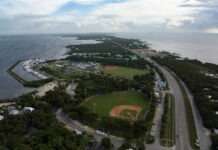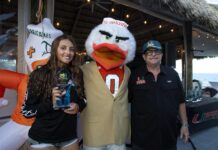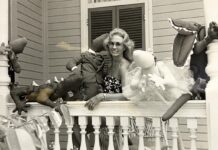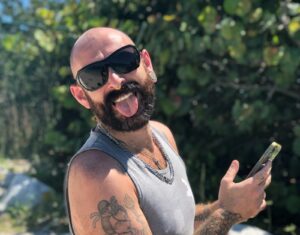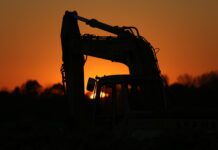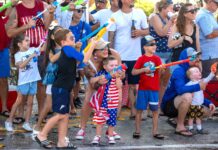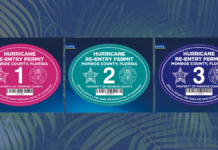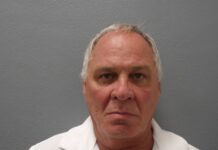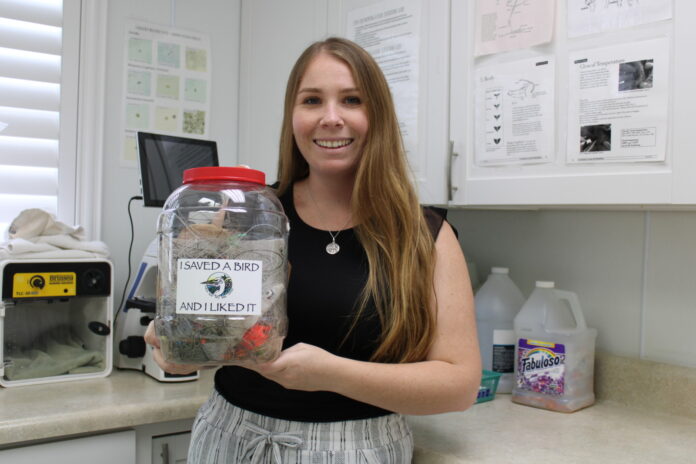
By Julia Arin
Once a horse-loving little girl born in South Miami-Dade, Erin Allison now serves as the executive director of the Florida Keys Wild Bird Rehabilitation Center.
The 25-year-old Tavernier resident started the job on June 19. She’s young for an executive, but far from inexperienced. A lifetime of interest and studies in animals, conservation and environmental education have landed her here.
Allison is a self-prescribed “horse girl” who grew up going on trail rides through the Everglades and earned a certification in therapeutic horseback riding instruction.
“I have just always been called to a job that is hands-on, active, outdoors,” she said.
Since she was about 9 years old, Allison spent weekends and summers visiting her father at his home in Key Largo. Then, just before the start of high school, Allison moved to the Upper Keys permanently. She graduated from Coral Shores High School in 2016 and received a scholarship from the Upper Keys Rotary Club to attend Florida International University. After a couple changes to her major, which originally was communications, Allison updated the Rotary Club on her academic and professional accomplishments. She was set to complete an environmental education internship with the Georgia Department of Natural Resources in the middle of her undergraduate studies. Rotarian Frank Derfler was puzzled by the move.
Allison recalls Derfler asking her why she would go all the way to Georgia when help was needed right at home at the bird center. Six months and a completed internship later, Allison followed up with Derfler who put her in touch with Jordan Budnik, who was the nonprofit center’s former executive director from September 2018 to June 2023.
Budnik hired Allison to be the center’s outreach coordinator.
“I was exactly where I wanted to be,” she said. “Back home in the Florida Keys and working for the bird center.”
She served in that position for about a year starting in 2019. During that time, she increased presence at community events and schools, led volunteer projects, trained ambassador birds, worked with an artist to put up educational signs at the sanctuary and, most notably, created a reserve of educational lesson plans and activities with accompanying kits and materials.
“Something that’s always really struck me about Erin as being impressive is she lets her actions speak for themselves,” Budnik said. “Even when she went back to school and wasn’t working at the center, Allison would step up.
“Anytime we had a community event and she happened to be in town she would be there, without fail, volunteering and asking what she could do and showing that she had faith in the mission,” she continued.
Budnik is delighted to have Allison succeed her. It’s Allison’s drive, along with her compassion and gregarious personality that has already “breathed new life into the organization,” Budnik said.
“I really love seeing women in STEM fields and seeing young women in these executive STEM field positions is especially impressive to me,” she said. “I love the legacy of crazy bird ladies. I know people lovingly called me that when I was the director and I hope that the community carries that title on and gives it to Erin as well.”
Taking care of the people behind the rescued birds is a huge aspect and responsibility of the job, according to Budnik. Among the pressures of leading a nonprofit in the Florida Keys are dealing with a high cost of living and lack of affordable housing. FKWBC provides housing for the interns who work with the center for 6 months to a year. But even staff members struggle to afford to live in the Keys, according to Allison.


Among her many goals for the future, Allison hopes to eventually be able to secure staff housing so the organization can keep the people who love what they do.
Between her position as outreach coordinator and her title now, Allison decided to attend grad school at West Liberty University in West Virginia, where she earned a master’s degree in biology. The field biology program she became a part of allowed her to work on an education program called Project Crawdad under the Loughman Crayfish Conservation Lab. Elementary-age students in southern West Virginia were given hands-on experience collecting and learning about crayfish from local streams during a yearlong science series. She also worked on an online survey study that focused on improving the public’s perception of rattlesnakes. This work was formative for Allison, and she came away with much more than the stick-and-poke crayfish claw tattoo visible on her forearm: a deeper understanding of how people perceive and form connections with the natural world.
“It was the hardest thing I ever did and it absolutely prepared me for this,” she said.
But taking on the mantle of leading the bird center is no small feat either. Allison oversees a staff of five, with four interns and an avian care fellow. That team handles the hundreds of birds a year that are treated at the hospital and over 60 non-releasable birds that found a permanent home at the sanctuary. As of Aug. 23, 545 bird patients spanning 77 different species were already documented as getting care at the hospital, according to the center’s assistant director Bayleigh MacHaffie.
Their work of treating close to 1,000 native birds a year can seem daunting, but Allison emphasizes that their tiny but fiercely dedicated rehabilitation team led by the organization’s two wildlife rehab managers is what has led to the center’s increasing success. Over the last several years, release rates have gone up. In 2021, FKWBC’s release rate was 58%, and this year so far, the release rate sits at 68%.
The center’s release rate is higher than other rehabilitators’ averages across the country. A study of 58,185 individual wildlife cases from several New York State licensed rehabilitators from 2012 to 2014 showed a release rate of 50.2%, according to the National Library of Medicine.

Bayleigh MacHaffie agrees that team collaboration is to credit for those statistics.
“Being able to apply what we’ve learned through schooling or practice or conferences and things we do to stay on top of the most up-to-date practices in the rehabilitation field aids to that number going up,” MacHaffie said.
While the organization has been improving that release rate over the last several years, MacHaffie says that with Allison at the helm, a new sense of energy flows throughout the facilities.
“She’s so passionate about what she’s doing so I believe she’s really inspired the rest of our crew as well,” Machaffie said. “I think she’s done a great job at really letting everyone know that we’re here.”
When Allison isn’t handling what she lovingly calls the “boring administrative stuff,” she is planning events she hopes will continue a trend of the center’s expanded presence within the Upper Keys community like upcoming Owl-O-Ween, a family-friendly fall festival set for late October. She also works on looking for new opportunities for funding, coordinating community releases and is in the midst of revamping the center’s volunteer program.
Part of reaching out to the community has included the creation of the center’s monthly email blast, “From the Pelican’s Pouch.”
“I’m very excited to take this organization to the next level,” she said. “We are a pillar in the community, we’re part of the history. We’re very unique in terms of being the only organization that does this in the Upper Keys.”
Looking forward, Allison hopes to continue to increase attendance at the donation-based, no-entry fee Laura Quinn Wild Bird sanctuary where people get the novel experience of seeing up close and personal birds that were once wild. The public’s involvement doesn’t just stop at visiting the sanctuary though.
FKWBC services an area from Marathon up to Homestead. Across this 78-mile linear range, a community of over 99,000 people are able to turn to them for bird rescues, according to Allison. Emergency calls are taken 24/7 through their “birdgency hotline,” which is 305-852-4486 ex. 1.
With big plans for staff, infrastructure and programming, Allison looks forward to the future.
“The strength of the previous directors and the commitment to our mission and the dedication to the organization is something that I think started with Laura Quinn,” Allison said. “She had a lot of grit. That’s something that I saw through Jordan, her strong sense of leadership. That’s something I would love to carry on.”


